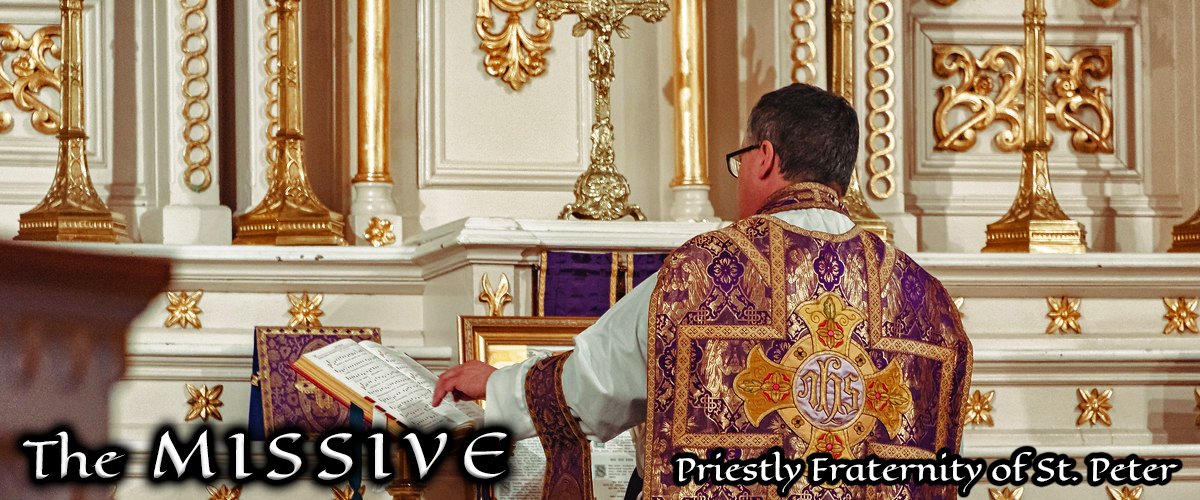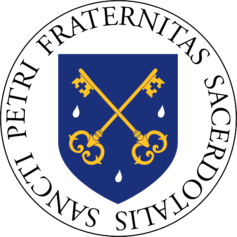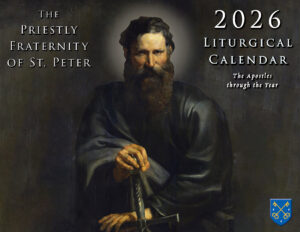“Ad Orientem”: Why is the Mass Celebrated Facing East?
by Fr. Hubert Bizard, FSSP
French original at claves.org.
Translated by Anastasiia Cherygova.
On one hand, the question of the priest’s orientation towards the altar is connected to another greater question of liturgical symbolism. On the other hand, it is connected to a more specific question of the orientation of prayer.
When it comes to liturgical symbolism, we should understand, first and foremost, that the gestures and attitudes in public prayer are never meaningless nor left to the private opinion of the celebrant (1).
The orientation of the priest at the altar is a part of the rites determined by the Church; this orientation is a part of an even more ancient orientation of prayer.
Orientation in Prayer
The phenomenon of orientation in prayer existed already in the Old Testament, when Jews would ordinarily pray facing the temple in Jerusalem, “where God resided”; also, thirty passages of the Old Testament demonstrate the practice of praying facing East. (2)
In the early Church, when liturgical symbolism was very important, turning East for liturgical prayer would very quickly become the common practice – thence comes the word itself “orientation”, from Latin orient, East. This practice would be so deeply entrenched that during a considerable period of time, starting from the 5th century, churches would be almost systematically built with their sanctuaries facing East. There is an abundance of contemporary witnesses to attest and justify this orientation of places of worship. (3)
Cardinal Bona, a great liturgist, wrote in the 18th century:
“From [looking] at the historic monuments, we may conclude that churches, in both the Greek and Latin Churches, were built in such a way that they were directed towards sunrise during the time of an equinox. This custom was formerly so strictly followed by the monks of the Cistercian Order that not only would their high altar be turned East, but all the other altars would be turned in the same direction.” (4)
This practice, however, was not completely universal. For instance, older Roman basilicas were “westernized” – this is why the priest and the faithful, for certain parts of the Mass when it comes to the latter, would turn to the doors in order that their prayer would still remain “oriented” – facing East.
“The Orient is his name”
Why turn to the East? Because it represents Christ according to the designation given by the prophet Zacharias (6:12): “Behold a Man, the Orient is his name.” He is again oriens ex alto (Luke 1:78). This is also where one of the Advent antiphons comes from: “Oh Orient, splendor of eternal light and the sun of justice, come and enlighten those who…”
Turning East then simply meant turning oneself to God. Some baptismal liturgies would prescribe even to the baptized neophytes to spit in the direction of the West, signifying renouncing Satan, before turning East to profess their faith and adhere to God. (5)
Turning East is also turning towards the direction of the rising sun, and, according to the prophesy of the prophet Malachi (4:2), Christ would be called “sun of justice”, sol justitiæ.
Moreover, with Christ having risen to the East during His Ascension, as per the prophesy of Psalm 67 (7), the East was also the same place whence His return was also expected. The “oriented”, East-facing prayer thus possessed also an eschatological dimension. (8)
Saint Thomas Aquinas himself in the Summa Theologiæ writes on the different motives of the orientation of prayer, adding to the discussion a common idea of the location of the Earthly Paradise being in the East:
“It is for reasons of propriety that we adore facing East. It is most especially because of the divine majesty that the East symbolizes, where the movement of heaven has its origin. Afterwards, it is there where the Earthly Paradise was established according to the text of the Septuagint (Genesis 2:8): we appear therefore to want to return there. Lastly, it is because of Christ, the light of the world who carries the name of Orient (Zacharias 6:12) and who “has risen above all the heavens in the East” (Psalm 78:34), whence we await His supreme return, according to Saint Matthew (Matthew 24:27): “As the lightning goes from the East and shines until the West, like this would be the return of the Son of Man. (9)”
And Today?
Even if it may be that, for generally practical reasons, through the centuries the orientation of the churches to the literal East had fallen into disuse, the direction of the minister and of the faithful would not. Together, they would be turned in the same direction, that of the cross, always present above or behind the altar. This is to say that they would still be facing God, the essential of the orientation being preserved.
To celebrate the Mass “with his back to the people” as it is said today sometimes, was never perceived as a way for the priest to turn his back towards the faithful, but rather and above all to turn with them to the Lord, since it is to Him that our prayers and our chants are addressed. It is to Him also that the sacrifice is offered.
If the celebration of the Mass today, according to the new liturgical books is done almost universally towards the people, let us make a note that the so-called Missal of Paul VI does not demand the celebration facing the congregation. Moreover, the Conciliar Constitution of the Second Vatican Council, according to which the Mass was reformed, did not once address the question of the position of the celebrant at the altar or demanded any changes in this matter.
References:
- Human nature is such that it is difficult for it to rise to the meditation of Divine things without the aid of supporting exterior aid. This is why the Church, as a pious mother, has instituted the rites, in virtue of which some formulas during the Mass would be pronounced silently, while others would be pronounced audibly. Similarly, instructed by the apostles and the tradition, she has established ceremonies, mysterious blessings, lamps, incensings, ornaments and many things of such usage meant to remind the majesty of such great a sacrifice, as well as to excite the spirit of the faithful to raise themselves through these exterior signs of religion and of piety to the contemplation of the very sublime things hidden in this sacrifice. (Council of Trent, 22nd session, chap. 5).
- Dom Gaspar Lefebvre, Manuel de liturgie, Ed. Apostolat liturgique, Bruges, 1934, p. 182. (tr. Manual of the Liturgy)
- According to the Apostolic Constitutions of the 4th century, it was ordained that the churches would be “elongated in the shape of a vessel and turned towards the East” (Les constitutions apostoliques, Ed. du Cerf, 1992, p. 112). Even earlier than that, Tertullian would write: “the house of our dove is simple, and [it is] turned to the light. The image of the Holy Spirit loves the east. It is towards the Eastern region that we pray.” (Adv. Val., c.3.) Saint Isidore of Seville would report centuries later that “when the ancients would build a temple, they would turn themselves facing the East of the equinox, in order that the one who would be in prayers would be turned to the real East” (Origines L. XV) The celebrant priest in the morning would see the sunlight illuminate him through the stained-glass windows.
- Migne, Dictionnaire d’archéologie sacrée, t. II, 1204 (tr. Dictionary of Sacred Archeology)
- When we rise to pray, we turn ourselves towards the East, there where the sun rises. It is not that God would be there, having abandoned other regions of the world… but rather to exhort the mind to raise itself towards a superior place, that is to say to God. (Saint Augustine, P.L. XXXIV, col 1277)
- Just as the East is the image of birth, it is also a figure symbolizing truth triumphing over error. Therefore we, Christians, have a habit of turning towards East when we pray. This is no longer like with the pagans, to adore the sun, but to adore the sun of justice and of truth. (Saint Clement of Alexandria in Dom Gaspard Lefebvre, Manuel de liturgie, Ed. Apostolat liturgique, Bruges, 1934, p. 183).
- Celebrate the Lord who rises to the highest heaven to the East.
- During the Ascension, He rose to the East, and it is in this direction that the apostles adored Him, and it is just like that that He will return, as they have seen Him ascend to Heaven, as He himself said the Lord: “as the lightning goes from the East is immediately in the West, the same would be the return of the Son of Man.” Since we are waiting for Him, we also pray towards the East. It is an unwritten tradition of the apostles. (Saint John Damascene, Orthod. Fidei., 1. IV, c. 13).
- Secunda Secundæ, q. 84, a.3 ad 3um (Saint Thomas Aquinas, Summa Theologiæ)
January 18, 2023








